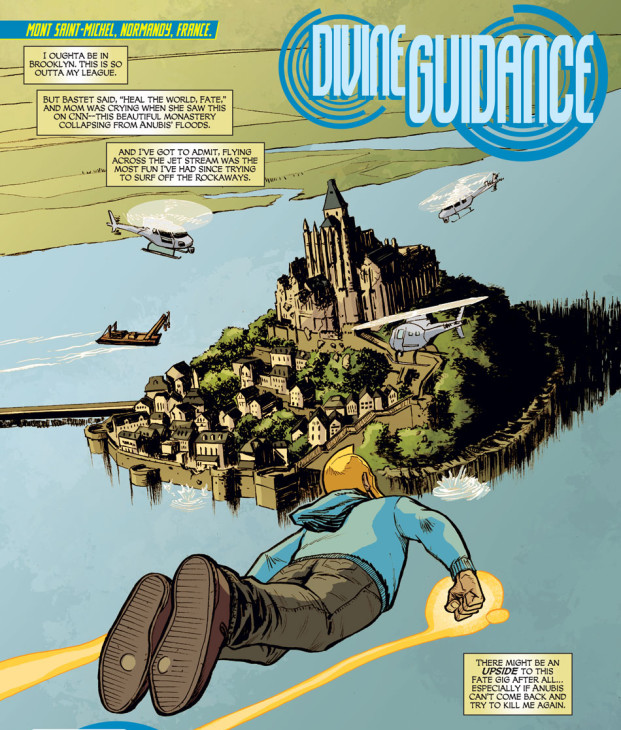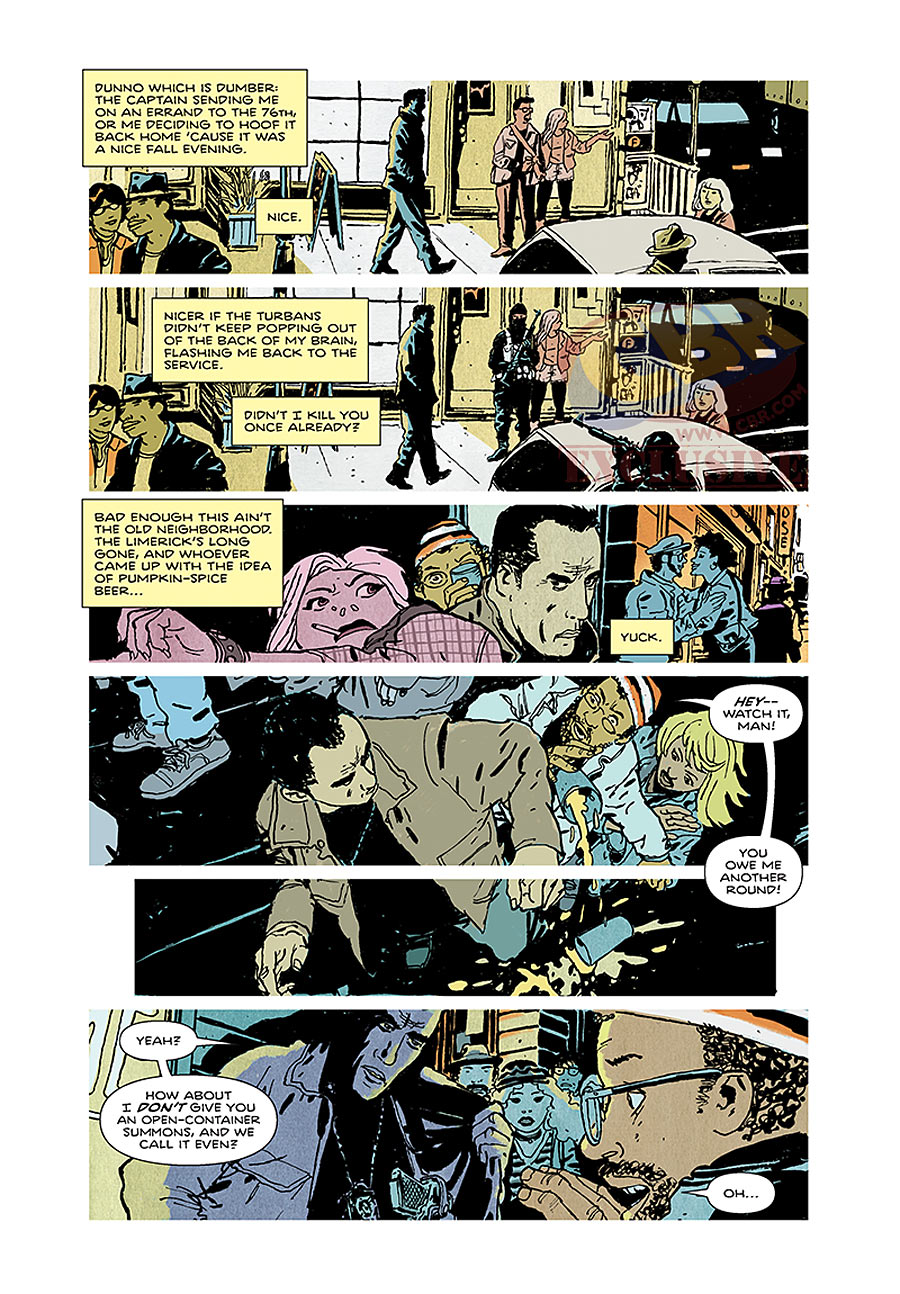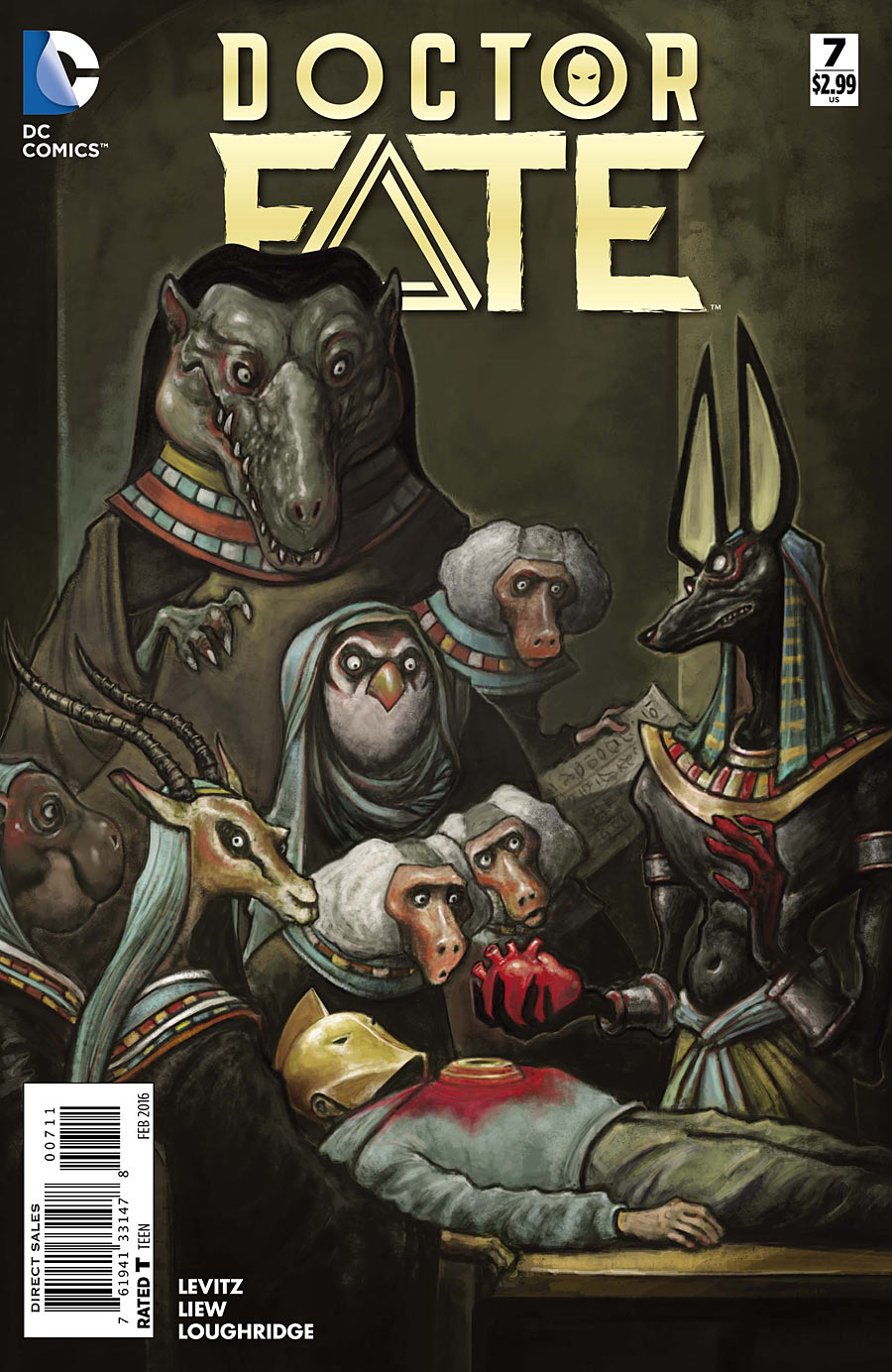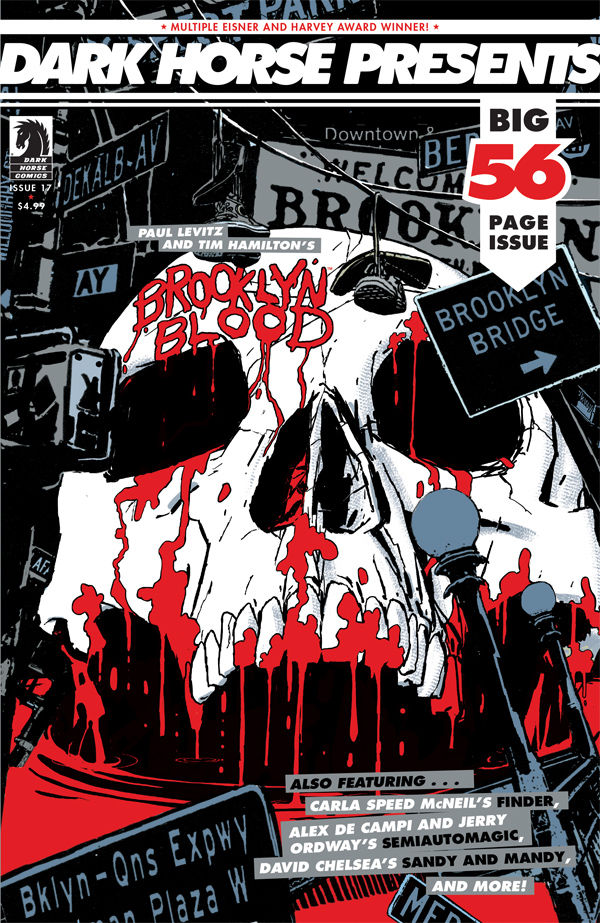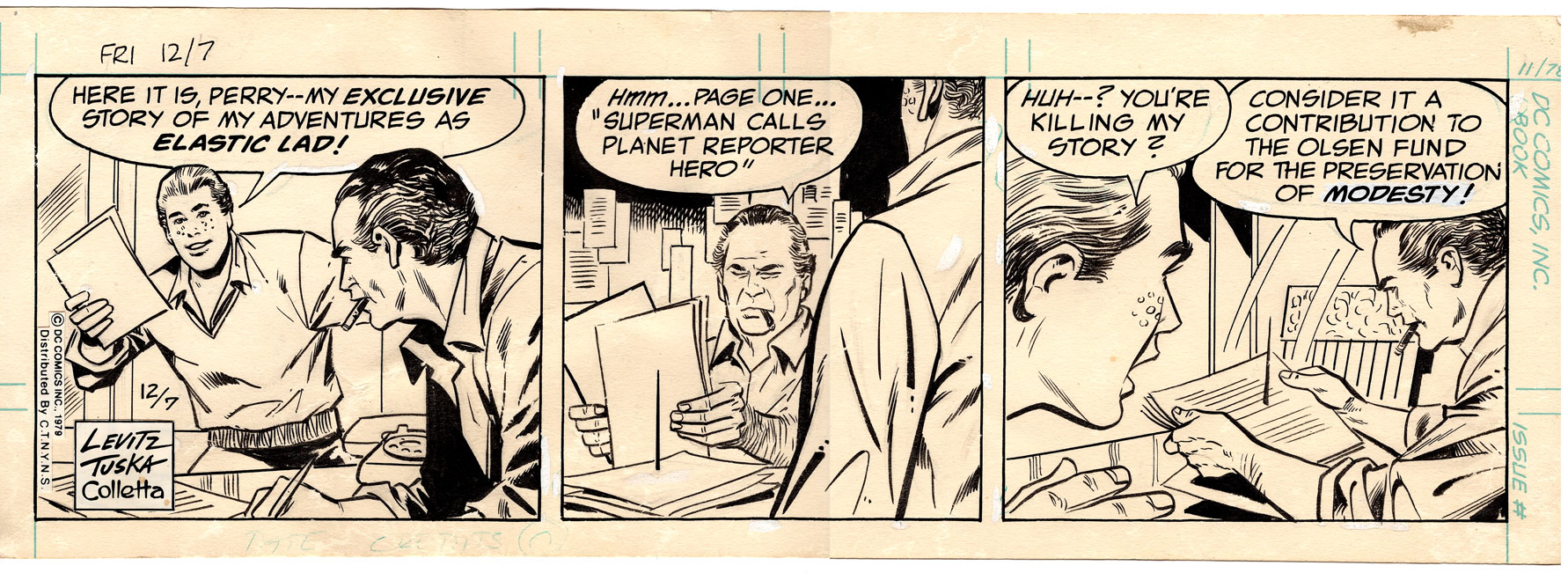With art by Tim Hamilton
With art by: Ibrahim Mustafa
Cover by: Sonny LiewCan young Khalid heal the world from the flood tides of Anubis while he wrestles with questions of faith and heritage? He’ll have to, for Fate has given the new hero no choice!
Preview the issue up at Comics Alliance!
Working on balloon-placing DR FATE today, and enjoying the careful detail that Sonny has used in researching a city so far from his home. It’s been fun writing art directions that include Google images, and even directions of flight over the city, and seeing what Sonny turns them into.
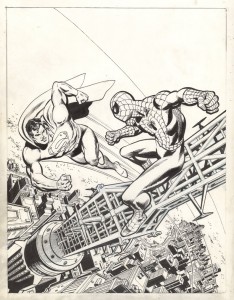 Looking at the scene in this issue set on the Manhattan Bridge walkway reminded me of the wonderful work of Ross Andru. Ross was a sweet man, and utterly dedicated to his art. I knew him from the time we worked on the first SUPERMAN VS. SPIDER-MAN tabloid to his period as a DC editor, when he was just down the hall. In his SPIDER-MAN days, Ross wanted to get his New York scenes just right, and would go up on the rooftops of Manhattan’s buildings with his camera, taking reference shots so he could get Spidey’s perspective. It’s probably impossible to do that in these post 9-11 days, but back in the ’70s, Ross got access to building after building.
Looking at the scene in this issue set on the Manhattan Bridge walkway reminded me of the wonderful work of Ross Andru. Ross was a sweet man, and utterly dedicated to his art. I knew him from the time we worked on the first SUPERMAN VS. SPIDER-MAN tabloid to his period as a DC editor, when he was just down the hall. In his SPIDER-MAN days, Ross wanted to get his New York scenes just right, and would go up on the rooftops of Manhattan’s buildings with his camera, taking reference shots so he could get Spidey’s perspective. It’s probably impossible to do that in these post 9-11 days, but back in the ’70s, Ross got access to building after building.
His art always had clear storytelling (I was a fan of his work on the early issues of METAL MEN before I knew to pay attention to credits, or even thought about the fact that actual people created comics), but his work in the ’70s is a great textbook both for storytelling and clear composition of a page. I still send artists back to that work to look at how the line structure of panels can add to one another to make a page more dynamic. (It’s a hard concept to describe without picking up a pencil to mark up the pages, but think about the similarity of Ross’ work to Walt Simonson, or Gil Kane, or Jose Luis Garcia Lopez in their starkly clear compositions, and you may see it.)
One of the occasionally contentious and often confusing questions in comics is the nature of the collaboration between writers and artists. Leaving aside the grand debates about Stan’s work with Jack and Steve since all three are or were friends, even in the much more modest cases there’s often no clear cut boundaries that are consistent from situation to situation.
So when I’m working with an artist in a true collaboration, inviting them to participate in the direction of the story and its structure, I’ve often adopted the practice of jointly asking us to be credited as “storytellers.” This last month’s issues provide some interesting examples of that, which I thought I’d share.
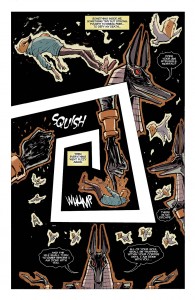 DOCTOR FATE #7 was a particularly challenging (and therefore particularly delightful) art task–largely inventing a view of the Duat, the Egyptian underworld. Unlike the Greek/Roman land of the dead, it’s largely unknown to modern readers, and didn’t have a long tradition of being depicted in Western art. Some depictions survive from when it was an active religion rather than a historic mythology, but not much. So Sonny had a lot to do in bringing the dead to life, and he did it in incredibly well. I got a book of Egyptian mythological art from Columbia’s library, ordered a dupe for him and shipped it off to Singapore, and we went to work.
DOCTOR FATE #7 was a particularly challenging (and therefore particularly delightful) art task–largely inventing a view of the Duat, the Egyptian underworld. Unlike the Greek/Roman land of the dead, it’s largely unknown to modern readers, and didn’t have a long tradition of being depicted in Western art. Some depictions survive from when it was an active religion rather than a historic mythology, but not much. So Sonny had a lot to do in bringing the dead to life, and he did it in incredibly well. I got a book of Egyptian mythological art from Columbia’s library, ordered a dupe for him and shipped it off to Singapore, and we went to work.
But he also contributed to the story structure. The way I’d set up the final battle didn’t choreograph particularly well for him–how Thoth’s staff merged with Khalid’s DNA and the bouncing around of Khalid’s heart didn’t make a clear visual story. So Sonny built out an alternative choreography, and I adjusted the copy a little to fit.
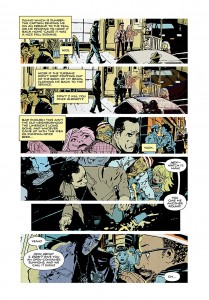 BROOKLYN BLOOD premiered this month too, and because of geography, this represented a different kind of collaborative opportunity. Tim Hamilton and I were able to get together a couple of times to flesh out the story as it will evolve over its 15 or so chapters, and he’s been able to make suggestions based on the years he’s been living in Brooklyn of specific locales in addition to the ones I called from my old days in Brooklyn or more recent visits.
BROOKLYN BLOOD premiered this month too, and because of geography, this represented a different kind of collaborative opportunity. Tim Hamilton and I were able to get together a couple of times to flesh out the story as it will evolve over its 15 or so chapters, and he’s been able to make suggestions based on the years he’s been living in Brooklyn of specific locales in addition to the ones I called from my old days in Brooklyn or more recent visits.
I’ve been incredibly lucky in my collaborators over the years, and while some of the great artists had no desire to get involved beyond their officially appointed tasks, it’s great fun to play with those who do. And of course, some of the artist who’ve drawn my stories are also brilliant writers too (I knew Keith should be writing comics long before he started to…).
With art by Sonny Liew
One of the most acclaimed new DC Comics series concludes its first amazing epic as Anubis defeats Fate and takes his body and soul on a surreal journey into the ancient and mystical House of the Dead.
Paul Levitz and Tim Hamilton premiere Brooklyn Blood! In a precinct not known for murder, a killer is on the loose. If Detective Billy O’Connor’s PTSD doesn’t get in the way, he may be able to help his partner Nadira Hasan solve this eerie case.
With art by Sonny Liew
New York City goes dark as the new Doctor Fate battles the ancient god Anubis to the death—but gods can’t die, can they?
It’s been a delight to get to know Jules while working on my new Eisner book, and to do a couple of convention events with him talking about Will, Jules’ own recent graphic novel efforts, and the world of noir. Right now I’m re-reading his memoir, BACKING INTO FORWARD, making notes for our upcoming conversation at the SVA Theatre next Wednesday.
He’s arguably the most diversely accomplished creative person to work in comics in America, at least if you judge by the shelf of awards, and I’m very curious to see if he can articulate a theory of why comics are such an appealing medium for us to work in. And we’ll talk a lot about Will, and some of my pet theories about Will that are embodied in the book. But if you have thoughts about good areas of discussion, comments please!!
Hope to see you there.
The background of this post is a daily SUPERMAN that I wrote around 1980, during my two year run on the newspaper strip. It’s kind of a charming moment, and in its own way reflects the paranoia that every writer has about every editor (or publisher) sometimes…are they doing this because they hate me? Perry’s being his customary blunt approach to goad Jimmy a bit.
I was particularly fond of this one because it felt like a real personality piece, and George Tuska was at his best on the strip capturing human expressions like Jimmy’s frustration and shock. And it was among the handful of originals that George and Vinnie passed on to me as souvenirs of our collaboration, back in the days when most pieces of original art couldn’t be valued at more than a McDonald’s lunch. In the early days of original art being returned, I even recall Vinnie selling his by taking a ruler to the stack of returned pages, and offering a price per inch of the pile. They’d both be amazed at what some of their strips are going for now.
But this is one I never hung up. Given my role as publisher (or just the ‘business guy’ before I got that title), I had to make the decision not to publish things fairly often. Sometimes wisely, sometimes not so much (particularly with the benefit not only of hindsight but of facts not available at the time). And while I hope I never made those decisions capriciously, or in the spirit that Perry’s expressing here, I felt that hanging up the strip where it would be read by our contributors would probably be sending the wrong message…
Will Eisner: Champion of the Graphic Novel and my career:


